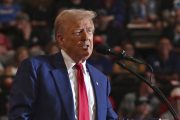
Federal Reserve Chairman Ben Bernanke signaled that the Fed would return to another round of “quantitative easing” (QE) in his August 31 annual address from Jackson Hole, Wyoming, a speech that also claimed economic success for the Fed’s past two QE purchases of federal debt securities.
The Wall Street Journal‘s MarketWatch.com noted that Bernanke “made it clear that he’s ready to pull the trigger. The only question that remains is whether it will happen in mid-September or December.” The Federal Reserve has also kept its “Federal Rate” interest rate to banks at historic lows, from one-fourth of one percent to zero, in an effort to spur more borrowing. Bernanke said in his address that “the Federal Reserve will provide additional policy accommodation as needed to promote a stronger economic recovery and sustained improvement in labor market conditions in a context of price stability.”
Bernanke also touted the fact that “a study using the Board’s FRB/US model of the economy found that, as of 2012, the first two rounds of LSAPs [Large-Scale Asset Purchases of Federal debt] may have raised the level of output by almost three percent and increased private payroll employment by more than two million jobs, relative to what otherwise would have occurred.” But the Federal Reserve chairman does admit that “obtaining precise estimates of the effects of these operations on the broader economy is inherently difficult, as the counterfactual — how the economy would have performed in the absence of the Federal Reserve’s actions — cannot be directly observed.” The current economic recovery is the weakest on record, despite the claimed success of the Fed’s QE. In fact, if QE has been so successful, why is it that, as Bernanke claimed, “following every previous U.S. recession since World War II, the unemployment rate has returned close to its pre-recession level, and, although the recent recession was unusually deep, I see little evidence of substantial structural change in recent years.”
Bernanke offered no reasons why this was the case, other than a few vague notations about international economic “headwinds,” such as the European debt crisis. There have been several structural changes in the U.S. economy since the 1980s, despite Bernanke’s claim, when the United States had its last robust recovery from a recession. The “National Savings Rate” has plummeted from more than 20 percent in 1981 in the throes of the Reagan-era recession to only 13 percent this year. And the national debt has increased from just 41 percent of Gross Domestic Product in 1981 to a near-historic high of 106 percent of GDP this year. Advanced economies with high national savings rates and low debt have reliably seen significantly higher economic growth, according to International Monetary Fund figures of the 34 advanced economies since 1980.
But the Federal Reserve Bank’s suppression of interest rates using the “Federal Rate” discount to banks has encouraged Americans to borrow and spend rather than to save and invest. Bernanke touted the claim that “Model simulations conducted at the Federal Reserve generally find that the securities purchase programs have provided significant help for the economy.” But the economic impact of the Federal Reserve’s suppression of interest rates and the resultant lowered national savings rate have apparently not entered into the “modeling simulations” conducted by the Fed.
Moreover, these claims of QE helping the economic recovery come even as Bernanke acknowledges that the economic recovery will likely continue to under-perform: “Growth in recent quarters has been tepid, and so, not surprisingly, we have seen no net improvement in the unemployment rate since January. Unless the economy begins to grow more quickly than it has recently, the unemployment rate is likely to remain far above levels consistent with maximum employment for some time.”
Despite the lackluster results from the QE and interest rate suppression, Bernanke plans to forge ahead with the purchase of more long-term federal debt securities: “One mechanism through which such purchases are believed to affect the economy is the so-called portfolio balance channel, which is based on the ideas of a number of well-known monetary economists, including James Tobin, Milton Friedman, Franco Modigliani, Karl Brunner, and Allan Meltzer.” Bernanke’s list constitutes a short list of the most prominent Keynesian/Behavioral school (James Tobin, Franco Modigliani) and Neo-Classical/Monetarist school (Milton Friedman, Karl Brunner, Allan Meltzer) economists in the establishment stable. Bernanke cited these economists to justify how “the FOMC has focused on the acquisition of longer-term securities — specifically, Treasury and agency securities.” In other words, the Federal Reserve has shifted in the last year from buying short-term federal debt to purchasing longer-term debt, the so-called “maturity extension program (MEP).” Bernanke says he had taken this policy from Milton Friedman’s suggestion in the year 2000 for Japan to fight deflationary pressure: “Friedman argued for large-scale purchases of long-term bonds by the Bank of Japan to help overcome Japan’s deflationary trap.”
Bernanke put his two cents in on what Congress should do over the next couple of years: maintain high federal spending and pass huge tax increases. Of course, he clothed the advice in virtually indecipherable wonk-speak: “It is critical that fiscal policymakers put in place a credible plan that sets the federal budget on a sustainable trajectory in the medium and longer runs. However, policymakers should take care to avoid a sharp near-term fiscal contraction that could endanger the recovery.”
Photo of Ben Bernanke at Jackson Hole: AP Images



